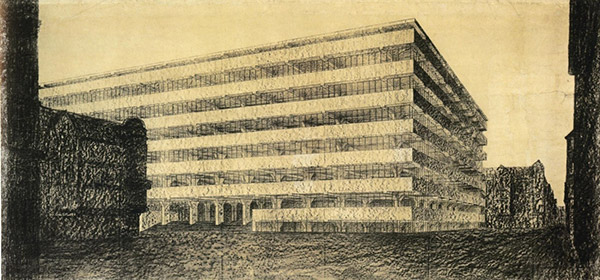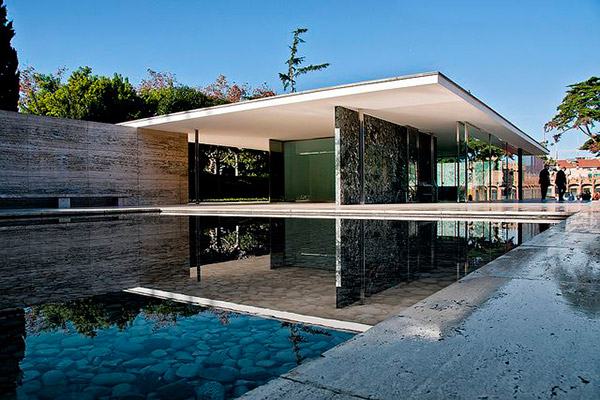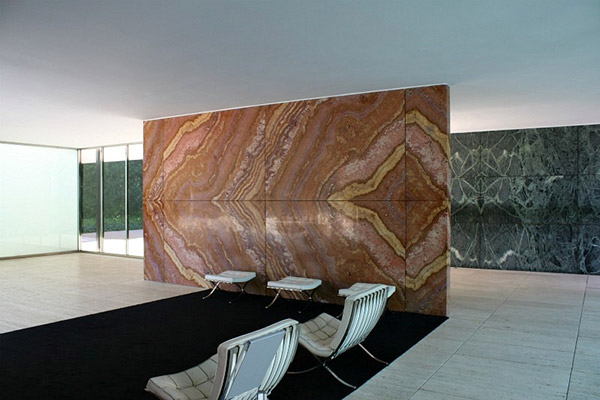Looking at the inspirations of this iconic architect and designer
Mies van der Rohe was an architect with notable draw skills. This gave him the opportunity to work in 1905 with Bruno Paul, having his first contact with Peter Behrens and Herman Muthesius. In 1908, Mies was working for Peter Behrens, Sandra Honey in European Works says:-
“Behrens gave Mies a respect for detail, a deep admiration for Schinkel and a valuable experience in the management of a large commission”1.
Mies had to fight himself to get away from the Classicism of Shinkel, but he never actually did; and this became more and more evident in his work.
Mies’ stance against high rise buildings
After the 1st World War and with the need to recover Germany socially and economically, Mies tried to find solutions in new technologies and materials. He considered that high rise architecture was made of trivial and meaningless forms, Mies himself, quoted by Franz Schule in Uma Biografia Crítica de Mies van der Rohe
“When they’re finished, these buildings, only impressed by the size, but they could be something more (…) we must develop the new forms form nature and the potential of new materials and situations. We can see clearly the new structural principles if we use glass instead of opaque walls, which is easy nowadays, in a skeleton building, the walls do not support loads. The use of glass provides new solutions.”2
The Office Building project
Mies’ Office Building Project in 1923 is a good example. Through a strict construction system, where console slabs supported by columns grab the ledge of the plan which grabs the windows, leads to a clean, fluid space with a relationship with the outside. From this moment, the utilitas of Vitrúvio in his work became undefined by a fluid floor plan where the use is no longer objective.

Concrete Office Building Project, Sketch by Mies van der Rohe, 1923
The importance of horizontal space
In his second work phase more importance is given to horizontal space. Mies explores a clear system of spatial organization in which the constructive elements are compose of both part and the building as a whole. The vertical plan is given a different character: no longer holding the house, nor intending to protect its inhabitants, but to drive one in the space, not breaking the flow of the floor plan. This creates a new ambiguous sense of boundless space. Philip Johnson in European Works by Sandra Honey says:-
“Indoors and outdoors are no longer easily defined: they flow into each other.”3
Reinforcing this idea, Mies denies the symmetries given by vertical elements in classicism, and strengthens the horizontal symmetries making the floor more related to the ceiling. Even the right foot is fixed at 3,10m to balance the observer between these plans. The Barcelona Pavilion in 1929 is the perfectly expresses this phase.
The Barcelona Pavilion
The quality of the materials in this Pavilion gives the essential quality of the archtectural aesthetic to the simplicity of the form. Cristina Gastón Guirao in Mies: El proyecto como revelación del lugar says:-
“The basis of straight and simple lines, smooth planes, can solve the problem of the building without damage to the aesthetics. To do this, one must use rich materials. The marble in different shades, brass, and glass are mandatory supplements to modern style.”

Barcelona Pavillion, Mies van der Rohe, 1929, Photo by Paul J White
The Pavilion presents itself as a Greek temple where the greatness of scale and its inherent austerity is replaced by the nobility of materials and reflexes. The limits between interior and exterior are hardly recognizable. The Onix plan brings people inside due to is rare materiality.
The Pavilion defies gravity with the relationships it has created between the horizontal plans (floor plan and ceiling) with their reflective materials and the big glazed screens. To emphasize the lightness of the space, Mies dematerialises the ceiling support, giving the columns a cruciform plan and use a reflective stainless steel, which creates elegant elements with a minimal interior impact.

The Barcelona Pavilion, 1929. An interior wall created from marble, glass and travertine planes intersected. Photo by Stephanie and Steve Chambers